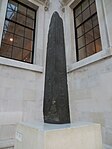The Elgin Marbles (), also known as the Parthenon Marbles (Greek: Γλυπτά του Παρθενώνα, lit. "sculptures of the Parthenon"), are a collection of Classical Greek marble sculptures made under the supervision of the architect and sculptor Phidias and his assistants. They are original parts of the Parthenon and other sacred and ceremonial structures built on the Acropolis of Athens in the 5th century BCE. The collection is on display in the British Museum, in the purpose-built Duveen Gallery.
From 1801 to 1812, agents of Thomas Bruce, 7th Earl of Elgin removed about half of the surviving sculptures of the Parthenon, as well as sculptures from the Propylaea and Erechtheion, and had them transported by sea to Britain. Elgin argued as his authority for this that he had obtained an official decree (a firman) from the Sublime Porte, the central government of the Ottoman Empire which, as ruler of Greece, was at that time the legal owner of the sculptures. This firman has not been found in the Ottoman archives despite its wealth of documents from the same period and its veracity is disputed. The Acropolis Museum displays a portion of the complete frieze, aligned in orientation and within sight of the Parthenon, with the position of the missing elements clearly marked and space left should they be returned to Athens.In Britain, the acquisition of the collection was supported by some, while some others, such as Lord Byron, likened the Earl's actions to vandalism or looting. Following a public debate in Parliament and its subsequent exoneration of Elgin, he sold the Marbles to the British government in 1816. They were then passed into the trusteeship of the British Museum, where they are now on display in the purpose-built Duveen Gallery.
After gaining its independence from the Ottoman Empire in 1832, the newly founded Greek state began a series of projects to restore its looted monuments and art. It has expressed its disapproval of Elgin's removal of the Marbles from the Acropolis and the Parthenon, which is regarded as one of the world's greatest cultural monuments. International efforts to repatriate the Marbles to Greece were intensified in the 1980s by then Greek Minister of Culture Melina Mercouri, and there are now many organisations actively campaigning for the Marbles' return, several united as part of the International Association for the Reunification of the Parthenon Sculptures. The Greek government itself continues to urge the return of the marbles to Athens so as to be unified with the remaining marbles and for the complete Parthenon frieze sequence to be restored, through diplomatic, political and legal means.In 2014, UNESCO offered to mediate between Greece and the United Kingdom to resolve the dispute, although this was later turned down by the British Museum on the basis that UNESCO works with government bodies, not trustees of museums. In 2021, UNESCO issued its first decision on the Parthenon Marbles, calling for the United Kingdom to return them to Greece.










